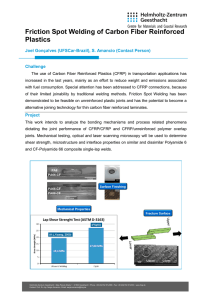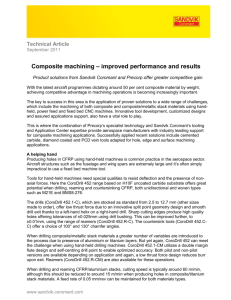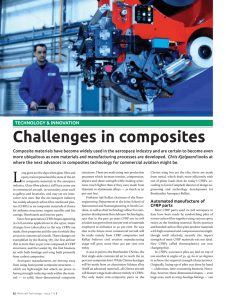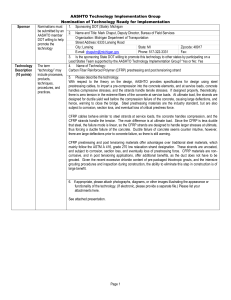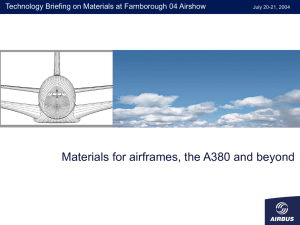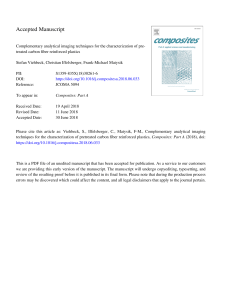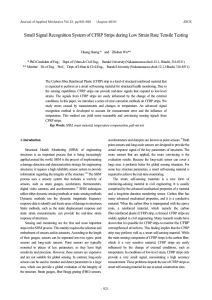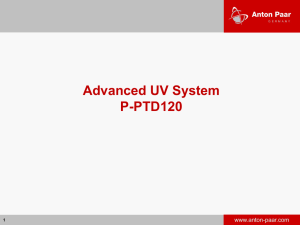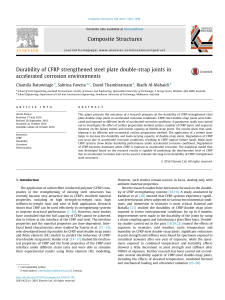PCCP CFRP Liners - International Concrete Repair Institute
advertisement
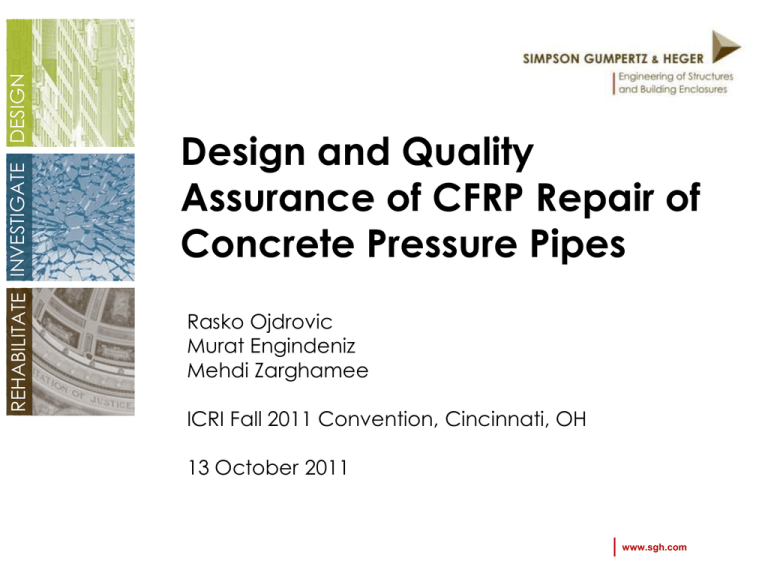
DESIGN REHABILITATE INVESTIGATE Design and Quality Assurance of CFRP Repair of Concrete Pressure Pipes Rasko Ojdrovic Murat Engindeniz Mehdi Zarghamee ICRI Fall 2011 Convention, Cincinnati, OH 13 October 2011 www.sgh.com Objective • Outline the design approach and present QA requirements for repair of PCCP with CFRP liners. • Introduce recent developments in the area (Draft AWWA Standard, the WaterRF Project). • Highlight consequences of lack of proper QA. 2 Outline • Introduction • Design Criteria • Draft AWWA Standard and the WaterRF Project • QA Requirements (prior to, during, and after construction) • Case Histories • Conclusions 3 Distressed Pipe PCCP 4 CFRP Liners • No need for external access • >15 year track record • Draft AWWA Standard in progress 28 in. pipe 5 CFRP Design Approach • Consider degradation level of host pipe • Stand-alone versus composite design (with inner core) • Use LRFD Circumferential Design Longitudinal Design Limit State Loads Limit State Loads CFRP Rupture Internal pressure + External gravity loads CFRP Rupture Internal pressure (Thrust, Poisson) + Temperature Buckling External loads including Groundwater + Vacuum Debonding Internal pressure (Thrust, Poisson) + Temperature Buckling Temperature Debonding 6 Empty pipe under external loads The WaterRF Project Objective: Develop all necessary technical background for an LRFD-based AWWA Standard. Task 1 Literature Review 2 Design Requirements 3 FEA of Soil-Structure Interaction 4 Buckling of CFRP Liner 5 Constrained Soil Modulus 6 Bond Strength Test 7 Hydrostatic Pressure Test 8 Three-Edge Bearing Test 9 Reliability Analysis 7 Time Effect Factor Resistance Factor Adjustment Factor The WaterRF Project – Analysis Account for: • CFRP-pipe-soil interaction for different soils • Installation condition • Construction sequence • Concrete cracking and CFRP debonding Backfill Native Soil Soil cover Rock Determine: • • • • • 8 Load on pipe Failure pressure Shape factor, Df Rerounding coefficient, Rc Debonding behavior Bedding The WaterRF Project – Testing Hydrostatic Bond Strength 9 Three-Edge Bearing QA Requirements • Prior to Construction – Parties' Experience, Materials, Inspection • During Construction – Testing, Installation, Independent Inspection, Curing • After Construction – Inspection, Testing 10 Involved Parties Prior to Construction • Owner: Provides pipe design data and design loads (working and transient pressure, vacuum, live, etc.) • Engineer: Designs repair, responsible for QA/QC of repairs. • Manufacturer: Supplies a complete CFRP repair system. Must provide all required material data and supporting test results and installation guidance, and must license and train installers. • Installer: Installs CFRP according to drawings and specifications; qualified by manufacturer and experienced in confined space installation of CFRP. • Special Inspector: Engineer’s representative who monitors and documents all phases of construction for compliance with repair drawings and specifications and directs corrective actions. • Testing Agency: Qualified testing laboratory independent from the Installer. 11 Laminate Qualification Short-term Engindeniz et al. 2011 Characteristic Value (ASTM D7290) 12 Design Value Laminate Qualification Durability Engindeniz et al. 2011 Creep Rupture 13 Resin Qualification • • • • • Primer Tack Coat Thickened Epoxy Impregnating Resin Top Coat • Tg > Tmax + 40°F • Long-term water absorption <2% • Curing performance documented with test data • Temp. vs. % cure • % cure vs. hardness • NSF 61 compliance • No VOC 14 Inspection of Host PCCP Identify: • • • • Cracks Surface irregularities (waviness imperfection) Ovality (another imperfection) Quality of inner core concrete Affects: • • • • 15 Design approach (standalone vs. composite) Surface preparation Buckling strength of CFRP liner Special details at cracks Dv Dh Independent Inspection • Engineer’s or Owner’s representative During Construction Punctured steel cylinder • Full time • To verify all construction activities, including: Raised fabric edge 16 Independent Inspection • Condition of host pipe • Surface preparation (minimum ICRI CSP3 required) • Testing of mockup panels (bond strength) for onsite verification of construction quality • Material storage, preparation, and application • Application (details, timing) • Control of air flow, temperature, and humidity • Termination details • Preparation of witness panels • Post-installation inspection • Curing (85% cure before service) 17 Mockup Panel Testing • Minimum (3) 2 ft x 2 ft panels • Prepared and tested by Installer (ASTM D4541) • Witnessed by Inspector • >200 psi required for at least 3 tests per panel – Failure mode may affect design approach! 18 Installation (1) Prepare Surface (4) Impregnate Carbon Fabric 19 (2) Apply Primer (3) Apply Tack Coat and Thickened Epoxy (5) Lay Fabric (6) Apply Top Coat Special Details End Termination Detail Outlets 20 Epoxy mortar Curing • >85% cure required prior to refilling the pipeline – Proper work schedule – Curing temperature and duration (consider elevated temperature) • Confirm with test data provided by Manufacturer – Temperature vs. % cure – % cure vs. hardness (Shore D or Barcol) 21 Witness Panel Testing • Prepared by Installer – 3 panels minimum – 1 layer of CFRP • Witnessed by Inspector • Tested by the Independent Testing Agency (ASTM D3039) • Evaluated by Engineer 22 After Construction Case Histories Over 40 successful projects in the last 3 years … • Constellation Energy Brandon Shores Power Plant – Lined (55) 102 in. PCCP under the switch yard (88,000 sq.ft application) in 22 days. – Lining of additional (51) 102 in. PCCP coming up. • Miami-Dade Water and Sewer Authority – Ongoing CFRP repair program on more than (70) 48 in. to 96 in. PCCP. – Utility able to perform repairs by minimizing impact on community. • APS Cholla Power Plant – Lined (20) 66 in. PCCP (22,000 sq.ft application) in 10 days. – Now planning additional CFRP repairs. 23 Lack of QA (by Others) Void in CFRP Debonded CFRP Improperly impregnated CFRP 24 Conclusions • Internal CFRP repair of pipes requires consideration of loads, limit states, and quality control procedures that are much different from those for other structures. • Owners should be active participants in the repair process to ensure selection of qualified engineers, materials, installers, inspectors, and testing agencies. • Manufacturers should be aware of the material qualification requirements, complete the missing data (e.g., creep, durability), and train Installers of their material. • Contractors should be aware of all QA procedures for material preparation, installation, and curing. • Lack of experience and quality control may lead to failure of CFRP liner. • A design and installation standard is currently under development by AWWA. 25 Questions ? Rasko P. Ojdrovic, Ph.D., P.E. rpojdrovic@sgh.com (781) 907-9231 26
